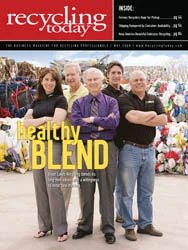Skeptics have coined terms such as "greenwashing" to refer to their perception of how corporations seek to appear to be concerned about the environment without taking any genuine action.
Recycling advocates can make fairly clear assessments in the case of some manufacturers and retailers as to whether they use recycled content in their products and/or set up recycling processes at their plants and offices.
Subsequently, the track records of corporations and their recycling-related decisions are found to be as widely varied as the decisions made within individual households. Some unapologetically recycle only when it makes financial sense, others show occasional bursts of activity when consumer trends seem to be skewing green, and others have adopted "zero waste" initiatives as both environmentally and financially sustainable.
While many "Then & Now" columns have looked at differences over the years, March 1991 Recycling Today coverage of the Green Marketing Summit of 1991 shows several similarities to that event and what has evolved with the annual Greenbuild Expo.
The Green Marketing Summit, which was co-sponsored by Advertising Age and Good Housekeeping magazines, attracted more attendees than expected to its Holiday Inn Crowne Plaza venue in Manhattan.
Presenters ranging from Bob Garfield of the Advertising Age staff to Bob Viney, a marketing manager with Proctor & Gamble, to Denis Hayes, then CEO of Green Seal, a nonprofit that develops environmental certification standards for consumer products, who offered advice and ideas on how companies can properly tap into the pro-environmentalist sentiments of American household consumers.
Survey results offered by a speaker from ad agency
Ogilvy & Mather noted that consumers most wanted corporations to pollute less and to offer products and packaging that did not contribute to pollution problems.
The United States Green Building Council (USGBC) was formed to create a certification system to help architects and builders create business structures, homes, hospitals, schools and entire neighborhoods that are what the USGBC deems as sustainable.
Several of the sustainable scorecard items established by USGBC involve using recycled-content products and recycling scrap materials generated at job sites.
Much as with the 1991 Green Marketing Summit, interest in the USGBC’s first several Greenbuild Expo events seemed to have taken even the organizers by surprise.
The USGBC has proudly tracked the growth of the event at its Web site (www.greenbuildexpo.org):
• 2002—4,200 attendees and 220
booths sold (Austin, Texas)
• 2004—8,100 attendees and 382
booths sold (Portland, Ore.)
• 2006—13,300 attendees and 477
booths sold (Denver)
• 2008—28,200 attendees and 807
exhibitors (Boston).
The 2008 event filled up a healthy percentage of Boston’s new convention center with exhibitors ranging from building products makers to general contractors to office and furniture supply companies. As large as the exhibit hall was, the aisles filled up with attendees, especially in between education session time blocks.
According to the Greenbuild Expo Web site, organizers of the event face challenges that are the envy of many other event organizers in 2009: "USGBC has worked through many challenges to accommodate the demand for new exhibit space as many eager and well-respected companies contact us each day."
The desire on the part of corporations to either be green or to appear green has been sustainable for the past two decades.
Get curated news on YOUR industry.
Enter your email to receive our newsletters.

Explore the May 2009 Issue
Check out more from this issue and find your next story to read.
Latest from Recycling Today
- Freepoint Eco-Systems receives $50M loan for plastics recycling facility
- PET thermoform recycling the focus of new NAPCOR white paper
- Steel Dynamics cites favorable conditions in Q1
- Hydro starts up construction in Spain
- Green Cubes unveils forklift battery line
- Rebar association points to trade turmoil
- LumiCup offers single-use plastic alternative
- European project yields recycled-content ABS





